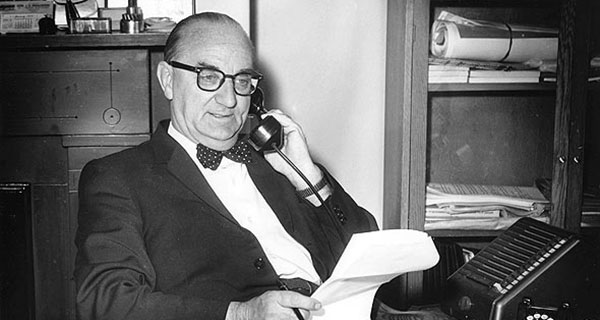 March 31 marks the 70th anniversary of Newfoundland joining Canada, a significant historical milestone in and of itself. It also facilitated the ascendancy of one of the 20th century’s most colourful Canadian politicians – Joey Smallwood.
March 31 marks the 70th anniversary of Newfoundland joining Canada, a significant historical milestone in and of itself. It also facilitated the ascendancy of one of the 20th century’s most colourful Canadian politicians – Joey Smallwood.
Newfoundland took a pass on the original 1867 Confederation, opting to remain with the arrangement that had been in place since 1855. Called Responsible Government, it meant that the elected assembly had effective control over the colony’s internal governance.
However, by the early 1930s things weren’t going well. Starting with the collapse of fish prices in the aftermath of the First World War, public finances deteriorated to the point where bankruptcy was in the cards.
So Britain stepped in, agreeing to provide assistance subject to the appointment of a royal commission of inquiry. The commission’s findings, known as the Amulree Report, were published in November 1933.
The bottom line recommendation called for temporarily suspending self-rule. Britain would resume direct control, guarantee and reschedule the public debt, and govern Newfoundland through an appointed commission.
Essentially, the report blamed Newfoundland’s predicament on poor administration, financial mismanagement and political incompetence. Whether fair or unfair, the recommendation was accepted and the Commission of Government took power in February 1934. Newfoundlanders were to be given a “rest from politics.”
By the end of the Second World War, Britain’s new Labour government wanted out of this responsibility. Accordingly, a national convention was established and 45 elected Newfoundland delegates were tasked with developing options to put before the electorate in a referendum. The convention met to begin the process in September 1946, committees were formed and debates were broadcast on the radio.
The British, however, had a particular ending in mind. Having obtained Ottawa’s prior agreement, they wanted Newfoundland to join Canada and were prepared to put a thumb on the scale to accomplish that result.
So when a convention delegation went to London in 1947 to inquire about support for restoring Responsible Government, they were told that no British assistance would be forthcoming in that eventuality. And when the convention voted against putting the Canada option on the referendum ballot, the British overruled them.
There was also the American question.
Thanks to the large presence of American military bases during the Second World War and significant intermarriage between American men and Newfoundland women, an interest in some form of union with the United States had percolated. This, though, didn’t sit well with London and Ottawa. Nor were the Americans particularly interested. Consequently, the option never made it to the referendum ballot.
As the voters went to the polls on June 3, 1948, they had three choices:
- return to Responsible Government;
- join Canada;
- remain with the Commission of Government for a further five years.
Although Responsible Government topped the poll, it fell short of an absolute majority and a second vote between the top two finishers – the Canada option having come in second – was thus required.
When that second vote was held seven weeks later, sectarian politics took a more prominent place on the stage.
Archbishop Edward P. Roche was an outspoken advocate of Responsible Government and dedicated opponent of the Canada option. To him, joining Canada would run the risk of diluting the traditional Roman Catholic influence in Newfoundland life. And while the Catholic vote wasn’t monolithic, the geographical distribution of the June 3 results indicated that a large majority of his co-religionists voted Roche’s way.
Smallwood, who was leading the Canada option forces, saw an opportunity. He would frame his advocacy as an appeal to “outport Newfoundlander’s sense of being British.” In his words, deploying the Union Jack “was a violent reminder of the fact that we were British, not American, and that Confederation would allow us to continue to be British subjects.”
Or to quote a more cynical observer, “the confederates found in Roche the perfect Irish-Catholic anti-confederate enemy, just the right sort of bogeyman needed in deepest outport Orange Newfoundland to create a Protestant backlash, and guarantee victory for confederation.”
On July 22, 1948, the Canada option squeaked home by just under 7,000 votes, setting the stage for Newfoundland to become the 10th province the following March.
And Smallwood was on his way towards dominating Newfoundland politics for almost the next quarter-century. That’s worth a column of its own.
Troy Media columnist Pat Murphy casts a history buff’s eye at the goings-on in our world. Never cynical – well, perhaps just a little bit.
The views, opinions and positions expressed by columnists and contributors are the author’s alone. They do not inherently or expressly reflect the views, opinions and/or positions of our publication.




